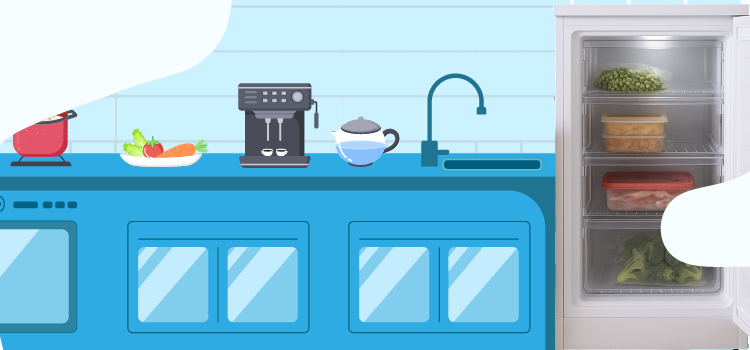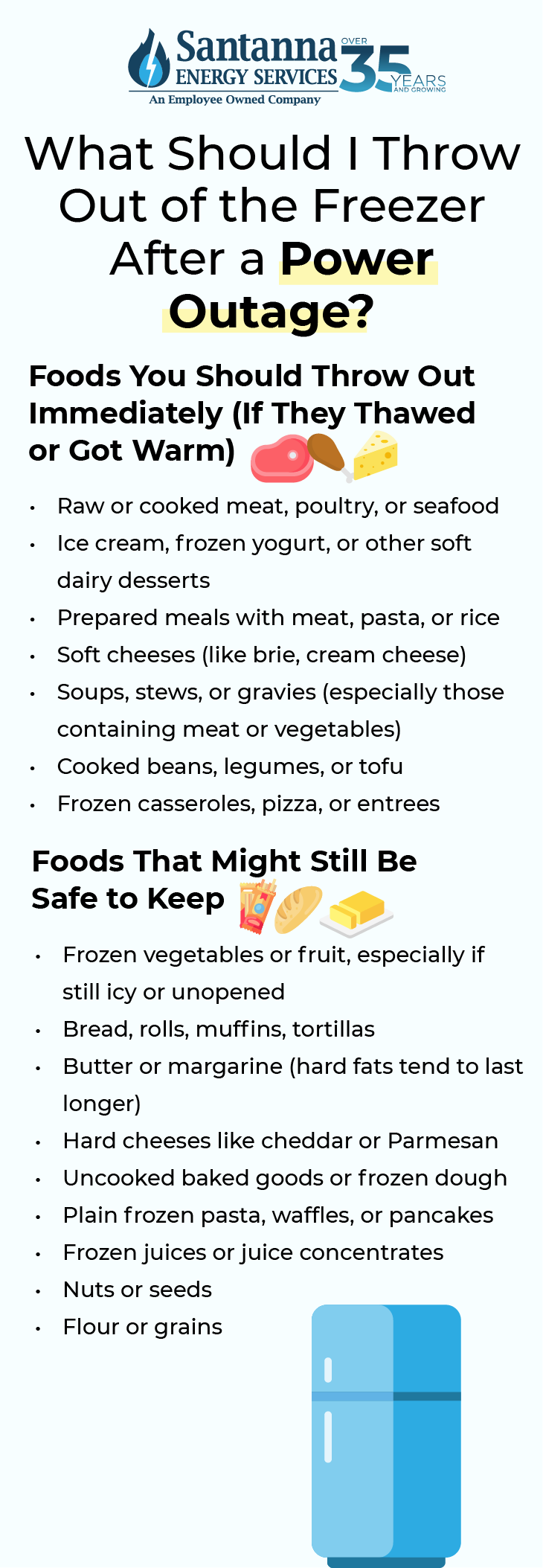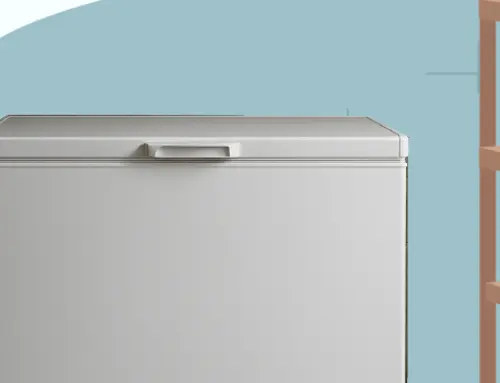What Should I Throw Out of My Freezer After a Power Outage?
by Jenna Mendez
26.2 min read

The storm has passed. The lights are back on. But as you open your freezer, a new question hits you: Is any of this food still safe to eat? As a Midwest native who has battled nasty weather and personally navigated the aftermath of multiple prolonged power outages (and the subsequent freezer clean-outs), I understand that immediate sense of dread and uncertainty.
Power outages can turn your fully stocked freezer into a source of uncertainty. And while some foods might look fine on the outside, they could be harboring hidden risks. Others might surprise you, and they're still perfectly safe if you know what to look for.
In this guide, I'll break down exactly what you should throw out after a power outage, using the latest information from food and safety guidelines from reputable organizations like the USDA and FDA, and drawing from my own experience.
Let's take the guesswork out of your freezer and help you make safer, smarter choices after the power goes out. I, along with Santanna Energy Services, am here for you!
Key Points of This Article:
- The most reliable way to determine if food is safe after an outage is by using an appliance thermometer to ensure the temperature stays at or below 40°F (4°C) in the fridge and 0°F (-18°C) in the freezer.
- A full freezer can keep food safe for up to 48 hours, while a half-full freezer can last about 24 hours, provided the door stays shut.
- Bacteria multiply rapidly in the "danger zone" between 40°F and 140°F (4°C and 60°C).
- Perishable foods (like meat, dairy, eggs, and leftovers) that have been above 40°F for more than two hours should be discarded, regardless of how they look or smell.
- If you are unsure about the safety of food after an outage, it's always safest to discard it to prevent foodborne illness.
How Common are Power Outages in the Midwest?
If you live in Pennsylvania, Illinois, Ohio, or other parts of the Midwest, you’ve likely experienced at least one power outage caused by severe weather. These events can be disruptive, unpredictable, and dangerous, especially when they hit during peak usage seasons like winter storms or summer heatwaves.
Power outages are more common in the Midwest than others in the U.S might realize. Here’s what the stats on power outages look like in 2025 in Illinois, Ohio, and Pennsylvania, as of July, according to WorldPopulationReview.com:
Pennsylvania Power Outages
As of July 2025, there were eight power outages that occurred statewide with a total duration of 10 hours.
After some research, I’ve learned that power outages in Pennsylvania tend to be shorter but more frequent. Like most outages, Pennsylvania’s are often caused by thunderstorms, fallen trees, or winter ice.
Illinois Power Outages
As of July 2025, five power outages were reported statewide in Illinois, lasting a total of 74 hours.
As an Illinois resident myself, my home is pretty equipped to handle power outages since the electrical systems in my area are primarily underground. But there were one or two that hit me harder than others. Let’s just say that my basement freezer smelled for a week after I cleaned out the rotten food.
Ohio Power Outages
As of July 2025, 11 power outages were reported statewide in Ohio, lasting a whopping 97 hours. These were mostly driven by strong storms, tornado warnings, and overloaded summer grids.
Common Weather Threats in Pennsylvania, Illinois, and Ohio That Cause Power Outages
As someone who’s experienced a fair share of power outages, I’ve learned that power outages can come from anything! Here are some of the most common causes of power outages:
- Thunderstorms and Lightning: One of the leading causes of power outages in the Midwest. Lightning strikes can damage power lines or transformers, triggering outages that may last several hours.
- Heavy Snow and Ice Storms: In winter, snow accumulation and ice buildup can cause trees and branches to fall on power lines. Ice can also weigh down lines and poles, leading to widespread blackouts.
- High Winds and Tornadoes: Strong wind gusts can knock over utility poles and bring down overhead lines, especially in rural and suburban areas.
- Extreme Heat Waves: During hot summer months, energy demand spikes as people run air conditioners. This can overload the grid, resulting in brownouts or rolling blackouts, especially in cities like Chicago, Cleveland, Columbus, and Pittsburgh.
How to Prepare Your Fridge and Freezer for a Power Outage
If you’ve ever lost power during a storm, you know how quickly the fridge becomes a worry. Is the food still good? How long will it stay cold? What can I do before the next outage to protect what’s inside? Believe me, the panic is real.
The truth is that most people don’t think about their refrigerator or freezer until it’s too late (me included). But with just a few simple steps, you can buy yourself extra hours of cold storage and avoid throwing away hundreds of dollars in spoiled groceries.
Here’s what I wish I’d known about preparing my fridge and freezer before a potential power outage hits:
1. Set Your Freezer and Fridge to the Right Temperature
Before anything else, make sure your appliances are running cold enough. If your appliances aren’t running at the appropriate temperature, you risk your food spoiling that much faster.
As a rule of thumb, set your freezer to 0°F and your refrigerator to 40°F or lower. Be sure not to set your refrigerator temperature too low, as this can actually cause frost and freeze food like milk, and you don’t want that either.
These are the safe storage temperatures recommended by the U.S. Department of Agriculture (USDA). If you set your appliances to anything warmer, bacteria can grow faster when the power goes out.
During a power outage, be sure to keep an appliance thermometer inside both the fridge and freezer. This helps you know if the temperature ever gets into the danger zone, even when the power is off.
2. Keep the Freezer Full (Even if You Fill It with Water)
A full freezer stays colder much longer than an empty one. That’s because frozen items act like ice packs, holding in the cold.
If you don’t have a lot of food stored, fill empty spaces with bottles or jugs of water and leave a little room at the top for expansion. Frozen gel packs or even zip-top bags of water do the trick as well. This was a lifesaver for me when my power went out in the summer.
This trick can add several extra hours of safe storage during an outage.
3. Organize Foods for Better Access
Move meats and perishables to one side or the bottom of the freezer. That way, if anything begins to thaw, juices won’t leak onto other items and contaminate them.
Keep frequently used items near the front so you can grab them quickly without holding the door open for too long.
4. Freeze Items That You Might Normally Refrigerate
Before a storm hits, consider moving some items from your fridge to the freezer, like bread, leftovers, and fresh meat—anything you think might spoil faster than others.
This buys you more time and keeps your fridge less full, which helps it stay colder longer.
5. Make Ice in Advance
Fill trays, containers, or bags with ice ahead of a storm. If the power goes out, you can move that ice into a cooler or keep it inside the fridge to help maintain the temperature.
6. Keep the Doors Closed
This might sound obvious, but it’s critical. Every time you open the fridge or freezer door during an outage, cold air escapes.
The more you open your doors, the less time you have before your food spoils. That means prepping ahead is your best bet for staying safe without constant worry.
How Long Can Food Last in a Power Outage?
When the power goes out, one of the biggest concerns is whether the food in your fridge and freezer is still safe to eat.
According to the U.S. Department of Agriculture (USDA), a full freezer can keep food safe for up to 48 hours, as long as the door stays closed. If your freezer is only half full, that time drops to about 24 hours.
The more frozen mass inside, the longer it holds the cold. I like to think of my freezer as a built-in ice chest. As long as your food still has ice crystals or remains at 40°F or below, it’s usually safe to refreeze or eat.
Your refrigerator, however, has a much shorter safe window. Perishable foods in the fridge stay safe for only about 4 hours without power, and that’s if the door stays shut.
Once the temperature inside rises above 40°F, harmful bacteria like Salmonella and E. coli can begin to multiply quickly.
After that 4-hour mark, high-risk foods like milk, eggs, meat, leftovers, and soft cheeses may no longer be safe, even if they look or smell fine. I’ve learned from experience that you should trust your gut if something smells or even looks off. If it’s questionable, it’s probably no good.
To protect your health and avoid guessing, it’s a smart idea to keep a refrigerator and freezer thermometer in place at all times. That way, you’ll always know whether your food stayed cold enough to be safe.
Understanding the Timeline: What Happens to Food in the Fridge and Freezer During a Power Outage
When the power goes out, it’s difficult to tell what your timeframe looks like for food spoilage. But I’ve learned that spoilage doesn’t happen all at once.
Here’s what happens hour by hour to your food during a power outage, so you can better understand what’s still safe and what’s at risk:
0 to 1 Hour: No Immediate Risk
In the first hour of a power outage, there’s generally no immediate food safety risk. Your refrigerator and freezer are still very cold, and the internal temperatures of your food should remain well within the safe zone of 40°F or below.
The key here is to keep the doors closed as much as possible. Every time you open the door, you let cold air out and warm air in, accelerating the warming process. So, resist the urge to peek!
1 to 2 Hours: Your Fridge Slowly Starts Warming
Within the second hour of a power outage, the situation in your fridge already begins to change.
Your refrigerator will slowly begin to warm up, especially if it’s not fully stocked. A fuller fridge tends to retain cold better. While high-risk items like milk, raw meat, seafood, and cooked leftovers are likely still safe at this point, always keep an eye on your temperature.
As your fridge warms and the temperature is inching towards the 40°F and above danger zone, the clock is definitely ticking.
2 to 4 Hours: Fridge Reaches Danger Zone
When you creep into the third and fourth hour of a power outage, this is a critical period.
After about three hours without power, your refrigerator’s internal temperature can reach 40°F or higher, and when this happens, your food enters the beginning of the “danger zone”, the range between 40°F and 140°F where harmful bacteria like Salmonella, E. coli, and Listeria can multiply rapidly, sometimes doubling in as little as 20 minutes.
The USDA advises that perishable foods that have been above 40°F for more than two to three hours should be discarded. This includes items such as:
- Meat, poultry, and seafood (raw or cooked)
- Dairy products like milk, yogurt, sour cream, and soft cheeses (e.g., cream cheese, shredded cheese)
- Eggs and egg products
- Cooked vegetables, pasta, and rice
- Cut fruits and vegetables
- Leftovers of any kind
While it’s tough to throw food away, the potential health risks of consuming contaminated food are severe.
4 Hours In: Discard Perishables in Fridge
By the four-hour mark, your fridge has likely risen above 40°F, and it’s time to discard all perishable foods. This is a non-negotiable step to prevent foodborne illness.
Items that must be discarded at this point include:
- All milk, yogurt, and most cheeses (unless hard, block cheeses)
- Raw or cooked meat, poultry, and seafood
- Lunchmeats and hot dogs
- Opened sauces, creamy dressings, and dips (e.g., mayonnaise-based, dairy-based)
- Cooked pasta, rice, and casseroles
You might be able to save some items like hard cheeses (e.g., cheddar, Swiss in block form), condiments (mustard, ketchup, pickles, jams, jellies), and certain fresh whole fruits and vegetables if they show no signs of spoilage, as they have a lower risk profile. However, when in doubt, throw it out!

My Power Was Out for 4 Hours and I Have Food in My Fridge—Am I Really at Risk?
Once the power has been out for four hours, your refrigerator becomes a risk zone for perishable food. And the short answer is yes, you’re really at risk of illness, and this isn’t the time to be lenient.
After 40 degrees, temperatures begin rising into what’s known as the “Danger Zone” and bacteria can multiply to unsafe levels in just a few hours, even if the food still looks, smells, or tastes normal.
That’s why the USDA advises discarding any perishable foods that have been above 40°F for more than two hours. Don’t try to save money by taking a risk and eating what might make you sick. It’s better to be safe than sorry.
While the fridge loses its cooling power quickly, your freezer is more forgiving.
If frozen food still has ice crystals or feels refrigerator-cold, it’s generally safe to refreeze or eat. But once it thaws completely and stays above 40°F for two hours or more, it should be discarded.
The best way to tell if your food has crossed into the danger zone is by using an appliance thermometer. Keeping one in both your fridge and freezer year-round is one of the easiest ways to make safe, informed decisions during a power outage.
So, I encourage you to stay prepared, as knowing what happens after four hours could protect not just your food, but also your family’s health.

What Should I Throw Out of the Freezer After a Power Outage?
After a power outage, one of the hardest decisions is figuring out what food in your freezer is still safe and what needs to go. It’s not always obvious, and the stakes are high.
Eating food that has been partially thawed or kept at unsafe temperatures can lead to foodborne illness. On the other hand, throwing away perfectly good food is costly and frustrating. So, how do you know for sure?
Don’t worry, I can help! Let’s walk through what to toss, what might still be safe, and what to look for before making the call, drawing on USDA and FDA food safety expertise:
Foods You Should Throw Out Immediately (If They Thawed or Got Warm)
According to the U.S. Department of Agriculture (USDA), frozen foods that have completely thawed and been above 40°F for two hours or more should be discarded.
Here are the high-risk foods you should always throw out if they’ve fully thawed:
- Raw or cooked meat, poultry, or seafood
- Ice cream, frozen yogurt, or other soft dairy desserts
- Prepared meals with meat, pasta, or rice
- Soft cheeses (like brie, cream cheese)
- Soups, stews, or gravies (especially those containing meat or vegetables)
- Cooked beans, legumes, or tofu
- Frozen casseroles, pizza, or entrees
- Anything with signs of spoilage, like weird smells, slimy texture, or unusual color. Even if a food hasn’t completely thawed but shows these signs, it’s unsafe.
These items can grow harmful bacteria even if they don’t smell or look “off.” When in doubt, it’s safest to toss them.
Foods That Might Still Be Safe to Keep
Some foods hold up better during an outage, especially if your freezer stayed cold enough (at or below 40°F) or you still see ice crystals in the packaging.
These may be safe to keep or refreeze:
- Frozen vegetables or fruit, especially if still icy or unopened
- Bread, rolls, muffins, tortillas
- Butter or margarine (hard fats tend to last longer)
- Hard cheeses like cheddar or Parmesan
- Uncooked baked goods or frozen dough
- Plain frozen pasta, waffles, or pancakes
- Frozen juices or juice concentrates
- Nuts or seeds
- Flour or grains
As a rule of thumb, if the food still has ice crystals or feels refrigerator-cold and hasn’t been above 40°F for more than two hours, it’s generally safe.
When it comes to power outages and perishable food, if in doubt, throw it out! Don’t try to be a hero and risk foodborne illness for the sake of saving a few items. Your health and the health of your family are far more valuable than any food in your freezer.
How to Tell If Food Is Spoiled—Even If It Doesn't Smell Bad
One of the most common misconceptions after a power outage is that you can tell if food is safe by how it looks or smells.
Unfortunately, that's not true, and relying on your senses could lead to serious illness. The USDA warns that dangerous bacteria like Listeria and Salmonella can multiply without changing the smell, look, or taste of food. That means food can look completely normal but still carry enough bacteria to make you sick.
Instead of using your senses alone, use this rule of thumb recommended by food safety experts:
- Check the time the food was left without power or above 40°F
- Use a thermometer to check if the internal temperature stayed below the safe threshold
- If you're unsure how long food has been warm—or didn't use a thermometer—it's safest to discard it
If in doubt, throw it out. It may feel wasteful, but it's far less costly than a trip to the ER or days of foodborne illness. Especially for children, pregnant women, seniors, and people with weakened immune systems, even one serving of unsafe food can be dangerous.
Keeping appliance thermometers in your fridge and freezer year-round is one of the smartest ways to make safe, informed decisions, so you're not left guessing the next time the power goes out.
Does Homeowners Insurance Cover Food Loss from a Power Outage?
According to Allstate, homeowners' insurance can cover food spoilage after a power outage, but not in every case, and limits can apply.
For example, if you have $500 worth of spoiled food and your policy only covers up to $250, you could still be looking at a loss.
Whether you're eligible for reimbursement depends on the cause of the outage and the specific details in your insurance policy. Always review your policy documents or call your agent to confirm your coverage.
That said, there are cases where food loss is not covered. If the outage was caused by a tripped breaker or blown fuse inside your home, or if the damage was due to user error (like leaving the fridge door open), the claim may be denied.
If your policy does include coverage, here's typically what to do depending on your insurance provider:
- Take photos of the spoiled food before throwing it out.
- Make a detailed list of the items and estimated values.
- File a claim online or by phone.
- Ask your insurer if food loss is covered under a separate clause—some will waive the deductible for this type of loss.
- Be sure to act fast: some policies require you to report the claim within 24 to 72 hours.
Best Food for a Power Outage
When the power goes out, especially for more than a few hours, you need food that's safe without refrigeration, easy to prepare, and ideally nutritious enough to get you through uncertain hours or days.
So, what are some of the best foods to have on hand during a power outage? Here's a list of food that got me through power outages:
1. Shelf-Stable Foods (No Fridge or Freezer Required)
These are your go-to items during any extended outage. They require no refrigeration and have a long shelf life. Try foods like:
- Canned goods: Beans, soup, tuna, chicken, fruit, and vegetables
- Nut butters: Peanut butter, almond butter—high in protein and calories
- Granola bars, protein bars, trail mix
- Crackers, rice cakes, dry cereal
- Dried fruits: Raisins, apricots, cranberries
- Shelf-stable milk or plant-based milks (in aseptic cartons)
- Canned or boxed pasta meals or chili
- Instant oatmeal packets (can be mixed with room-temperature water in a pinch)
2. Frozen Foods That Are Safer If They Partially Thaw
Some frozen foods can hold up better than others during an outage and can still be eaten safely if they've partially thawed (as long as they stay under 40°F or retain ice crystals). Here are a few of my go-tos:
- Bread and baked goods
- Frozen fruits or veggies
- Uncooked pasta sauces, soups, or stews
These are great to keep in your freezer during storm season—they're more forgiving than meats or dairy if the power goes out.
3. Easy-Prep or No-Prep Foods
During a power outage, you may not have access to cooking appliances or even hot water. Focus on foods that require little to no prep. Here are some great options:
- Ready-to-eat canned meals (don't forget a manual can opener!)
- Hard cheeses (like cheddar or Parmesan, which keep longer unrefrigerated)
- Jerky or dried meats
- Powdered or bottled electrolyte drinks (to stay hydrated)
Why Is My Freezer Not Working After a Power Outage?
Sometimes, even after the power comes back on, your freezer stays warm or doesn't seem to run like it did before. This can be stressful, especially when you're trying to salvage frozen food. But don't panic yet.
Here are a few common reasons your freezer might not start back up right away after an outage:
- Power Surge or Electrical Glitch: A sudden outage or power restoration can cause a brief surge in electricity. That surge may trip your circuit breaker, fry a fuse, or simply confuse the appliance's internal control system.
Be sure to check your circuit breaker box and reset any tripped breakers. Make sure the freezer is plugged in properly (sometimes vibrations or surge protectors get loose). And try plugging another appliance into the same outlet to see if power is flowing. If not, you'll need an electrician to inspect your appliance.
- Your Freezer Needs a Manual Reset: After a blackout, some freezers, especially digital or newer models, may require a manual reset to get back to normal. The process to reset will vary based on your model, so be sure to check your appliance manual for full instructions.
- It Might Just Need Time: After a long outage, it may take several hours for your freezer to get cold again, especially if it's full of thawed items or working overtime in a hot room. Give your appliance 4–6 hours to cool down and use an appliance thermometer to check that it reaches 0°F.
- Signs It May Need Repair: If your freezer still doesn't work after resetting, you hear it running or feel cool air after several hours, the internal light or display panel doesn't respond, and it's making unusual clicking or buzzing sounds, these are all signs your fridge needs to be repaired.
How to Reset a Frigidaire Freezer After a Power Outage
If you have a Frigidaire (or similar model), here's a general reset process that works for many upright or chest freezers:
Step-by-Step Reset:
- Unplug the freezer from the wall.
Give it a full minute. This clears the internal memory and stops any glitching. - Wait 30 seconds to 1 minute.
This gives the compressor and control board a chance to fully reset. - Plug the freezer back in.
Make sure it's firmly plugged into a working outlet—avoid power strips or surge protectors during the test. - Press and hold the reset button.
Some Frigidaire models have a small reset or "Alarm Reset" button on the control panel. Hold it for 3–5 seconds until you hear a beep or see the display respond. - Adjust the temperature if needed.
After a reset, your freezer may default to a standard temperature. Set it back to 0°F (-18°C).
If you don't see a reset button or this doesn't work, refer to your Frigidaire user manual. You can also search your model number on the official Frigidaire Support page.
How To Tell if Your Fridge Is Safe After an Outage
Once the power comes back on, your first instinct may be to check the lights and restart your appliances, but don't forget the fridge. The crucial question remains: Did your refrigerator stay cold enough to keep your food safe?
I've seen firsthand how quickly food can spoil when temperatures aren't maintained. Relying on guesswork after an outage can lead to serious health risks.
Here's a systematic approach, based on U.S. Department of Agriculture (USDA) and Food and Drug Administration (FDA) guidelines, to confidently determine if your fridge, and the food inside, is still okay after an outage:
1. Check the Temperature First
The most reliable and scientifically sound way to know if your refrigerator's contents are safe is by checking the internal temperature with an appliance thermometer. If the internal temperature is at or below 40°F, your food is likely still safe.
If your appliance thermometer reads above 40°F for more than 2 hours, perishable food may no longer be safe to eat and should be discarded.
2. Look for Obvious Signs of Spoilage
While an appliance thermometer is your best friend, if you don't have one, you'll need to exercise extreme caution and look for other indicators. However, do not rely solely on your senses, as many dangerous bacteria that cause foodborne illness do not alter the taste, smell, or appearance of food.
Nonetheless, these are red flags that indicate food has been warmed too much and bacteria may have grown:
- Unusual odors: Any sour, off, or putrid smells.
- Changes in texture: Sliminess on meats, stickiness on dairy, or a mushy consistency in produce that was previously firm.
- Discoloration: Unnatural browning, greening, or molding on items where it shouldn't be present.
- Puffed or leaked packaging: This is a strong sign of bacterial growth producing gases, particularly in items like vacuum-sealed meats or dairy products.
Remember, the absence of these signs does not guarantee safety. If you are unsure and don't have a temperature reading, it's safer to discard perishable items.
3. Consider How Long the Power Was Out
The length of the outage matters. Refrigerated food typically stays safe for up to four hours without power, if the door remained closed. After four hours, high-risk foods like milk, meat, eggs, and leftovers may be unsafe.
Low-risk foods, such as condiments (mustard, ketchup, jams, jellies), hard cheeses (like block cheddar or Parmesan), and some whole fruits and vegetables (if not cut or peeled), may still be safe beyond four hours, particularly if their packaging remains intact and they show no signs of spoilage.
4. Check the Condition of the Fridge
Once the power is back, it's also wise to quickly assess your refrigerator's performance. A fridge that isn't cooling properly, even with power, likely won't keep your food safe.
Ask yourself: Is it cooling normally again? Are there leaks, condensation, or unusual sounds? Do you need to reset the temperature setting after the power was restored?
Power outages can affect the performance of an appliance without you even knowing it. While everything might seem fine after the power is restored, problems could lurk when your appliance powers up again.
If your fridge isn't working properly, food inside may continue to spoil even after the power returns.
What Should I Do if My Fridge and Freezer Were Without Power Overnight?
If you wake up to find your fridge was without power overnight, it's important to act quickly and safely because by now, your food may no longer be safe to eat, even if it looks fine.
Here's what to do with the food in your fridge and if your freezer went without power overnight:
- Check the Internal Temperature: As I've said before, be sure to check your refrigerator's temperature. If it falls anywhere above 40°F, you'll want to discard any perishable foods right away.
- Discard High-Risk Foods That Have Warmed Up: Throw out anything that has been above 40°F for more than two hours, especially:
- Raw or cooked meat and poultry
- Seafood
- Eggs and egg-based products
- Milk, yogurt, and soft cheeses
- Opened sauces, dips, leftovers, and cooked vegetables
Even if these foods look and smell okay, they could still be dangerous to eat. Bacteria that cause food poisoning don't always give off warning signs.
- Keep or Refreeze Low-Risk Items: Some items can last a bit longer or can be refrozen if still cold:
- Hard cheeses (like cheddar or Parmesan)
- Unopened juice, pickles, mustard, and ketchup
- Butter or margarine
- Bread, tortillas, and baked goods
- Clean and Reset: Wipe down the inside of the fridge with soap and water to remove any leaks or odors. If the power is back on, set the fridge to 40°F or below to help it cool quickly. Be sure to place thermometers inside for ongoing monitoring in case of future outages.
FAQs
Can You Refreeze Meat, Ice Cream, or Frozen Veggies?
You can safely refreeze meat, poultry, and vegetables if they still have ice crystals or have stayed at or below 40°F. Ice cream, however, should always be discarded if it's thawed because of texture and bacteria concerns.
Can I Refreeze Food That Thawed but Is Still Cold?
Yes. According to the USDA, if thawed food has not risen above 40°F, it is generally safe to refreeze, though quality may suffer (especially texture). This applies to meats, fruits, veggies, and baked goods.
Is Butter Still Good After a Power Outage?
Yes, butter is more stable than most dairy. If it has stayed below 40°F and doesn't smell rancid, it's generally safe. Hard fats like butter can often last longer than milk or soft cheeses during outages.
Does Puffed or Bloated Packaging Mean Spoilage?
Yes, this is a strong warning sign. Swollen or bloated packaging may indicate bacterial growth and gas release, especially for vacuum-sealed or canned items, and it's safe to say you shouldn't consume this.
Power outages can happen unexpectedly, but with the right knowledge, you can protect your food, your family, and your wallet. Knowing what to keep, what to toss, and how to prepare your fridge and freezer ahead of time makes all the difference.
And while we can't control when the power goes out, Santanna's Unlimited Energy plan helps you feel more confident when it comes back on.
Whether you're restocking groceries, lowering the temperature, or running appliances more often after an outage, your supply charge stays the same under this plan. No spikes. No surprises. Just one predictable supply charge no matter how much energy you use.* Learn more about how Unlimited Energy helps you stay in control all year long.
* Restrictions apply. Enrollment based upon program eligibility. Customers using more than 125% of normal monthly usage as determined by Santanna may be required to switch plans.
Jenna Mendez is a Midwest native with lifelong roots in Illinois and time spent in Ohio during college, giving her a deep understanding of the Midwest region’s people, climate, and energy needs. She brings firsthand experience and local insight to topics that matter to Midwest homeowners, especially energy efficiency, sustainability, and home living. Jenna specializes in writing about eco-friendly living, all things Midwest, renewable energy, and practical ways to reduce energy costs. Jenna brings a trusted, and local hometown voice to every article she writes, helping readers live well, and sustainably, right where they are.







